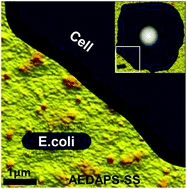Cell resistant zwitterionic polyelectrolyte coating promotes bacterial attachment: an adhesion contradiction†
Abstract
Polymers of various architectures with zwitterionic functionality have recently been shown to effectively suppress nonspecific fouling of surfaces by proteins and prokaryotic (bacteria) or eukaryotic (mammalian) cells as well as other microorganisms and environmental contaminants. In this work, zwitterionic copolymers were used to make thin coatings on substrates with the layer-by-layer method. Polyelectrolyte multilayers, PEMUs, were built with [poly(allylamine hydrochloride)], PAH, and copolymers of acrylic acid and either the AEDAPS zwitterionic group 3-[2-(acrylamido)-ethyldimethyl ammonio] propane sulfonate (PAA-co-AEDAPS), or benzophenone (PAABp). Benzophenone allowed the PEMU to be toughened by photocrosslinking post-deposition. The attachment of two mammalian cell lines, rat aortic smooth muscle (A7r5) and mouse fibroblasts (3T3), and the biofilm-forming Gram-negative bacteria Escherichia coli was studied on PEMUs terminated with PAA-co-AEDAPS. Consistent with earlier studies, it is shown that PAH/PAA-co-AEDAPS PEMUs resist the adhesion of mammalian cells, but, contrary to our initial hypothesis, are bacterial adhesive and significantly so after maximizing the surface presentation of PAA-co-AEDAPS. This unexpected contrast in the adhesive behavior of prokaryotic and eukaryotic cells is explained by differences in adhesion mechanisms as well as different responses to the topology and morphology of the multilayer surface.


 Please wait while we load your content...
Please wait while we load your content...